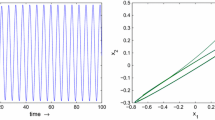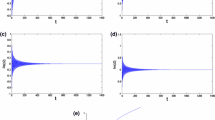Abstract
At present, there are few studies on the delayed kernel function of hyper-strong kernel. This paper attempts to analyze the stability and bifurcation of neural networks with distributed delayed hyper-strong kernels. Firstly, considering the average delay as a bifurcation parameter, the study discusses the characteristic equations of delayed kernels with weak kernel, strong kernel and hyper-strong kernel to provide sufficient conditions for the stability and generation of Hopf bifurcation. Secondly, it applies the normal theory and the center manifold theory to derive the formulas for determining the stability and direction of the bifurcating periodic solution. Finally, it verifies the correctness of the calculation results by numerical simulation with an example.









Similar content being viewed by others
References
Xia Y, Wang J (2004) A general projection neural network for solving monotone variational inequalities and related optimization problems. IEEE Trans Neural Netw 15:318–328
Wu Y, Feng J (2018) Development and application of artificial neural network. Wirel Pers Commun 102:1645–1656
Seow M, Asari V (2010) Learning as a nonlinear line of attraction in a recurrent neural network. Neural Comput Appl 19:337–342
Aleksandra W (2019) Regularization theory in the study of generalization ability of a biological neural network model. Adv Comput Math 45:1793–1805
Tong S, Wang T, Li Y (2014) Fuzzy neural network-based adaptive control for a class of uncertain nonlinear stochastic systems. IEEE Trans Cybern 44:910–921
Dong T, Bai J, Yang L (2018) Bifurcation analysis of delayed complex-valued neural network with diffusions. Neural Process Lett 8:1–15
Guo W, Yang J (2017) Hopf bifurcation control of hydro-turbine governing system with sloping ceiling tailrace tunnel using nonlinear state feedback. Chaos Solitons Fractals 104:426–434
Tian X, Xu R (2017) Stability and hopf bifurcation of time fractional cohen-grossberg neural networks with diffusion and time delays in leakage terms. Neural Process Lett 45:593–614
Tabekoueng Z, Laura C (2020) Remerging feigenbaum trees, coexisting behaviors and bursting oscillations in a novel 3D Generalized hopfield neural network. Neural Process Lett 52:267–289
Shen H, Zhu Y, Zhang L (2016) Extended dissipative state estimation for Markov jump neural networks with unreliable links. IEEE Trans Neural Netw Learn Syst 28:1–13
Cheng Z, Li D, Cao J (2016) Stability and Hopf bifurcation of a three-layer neural network model with delays. Neurocomputing 175:355–370
Yu W, Cao J, Chen G (2008) Stability and Hopf bifurcation of a general delayed recurrent neural network. IEEE Trans Neural Netw 19:845–854
Gan Q, Liang Y (2012) Synchronization of non-identical unknown chaotic delayed neural networks based on adaptive sliding mode control. Neural Process Lett 35:245–255
Huang X, Zhao Z, Wang Z, Li Y (2012) Chaos and hyperchaos in fractional-order cellular neural networks. Neurocomputing 94:13–21
Zhou Y, Xia J, Shen H (2019) Extended dissipative learning of time-delay recurrent neural networks. J Franklin Inst 356:8745–8769
Jing T, Zhang D, Jing T (2020) Finite-Time synchronization of hybrid-coupled delayed dynamic networks via aperiodically intermittent control. Neural Process Lett 52:291–311
Chen W, Luo S, Lu X (2015) Multistability in a class of stochastic delayed Hopfield neural networks. Neural Netw 68:52–61
Dong T, Gong X, Huang T (2022) Zero-Hopf bifurcation of a memristive synaptic Hopfield neural network with time delay. Neural Netw 149:146–156
Yang H, Yan X (2012) New stability criteria for neural networks with time-varying delays. Appl Math Comput 218:5035–5042
Gao H, Wang J (2020) Non-intrusive model reduction of large-scale, nonlinear dynamical systems using deep learning. Physica D 412:132614
Kundu A, Das P, Roy A (2016) Stability, bifurcation and synchronization in a delayed neural network model of n-identical neurons. Math Comput Simul 121:12–33
Luan X, Chen Q, Liu F (2018) Conversion of SISO processes with multiple time-delays to single time-delay processes. Journal of Process Control 65:84–90
Ma Y, Deng C (2022) Observer-Based fuzzy containment control for nonlinear networked mass under dos attacks. Appl Math Comput 421:126941
Li W, Li M, Hang J, Qiao J (2020) Design of a self-organizing reciprocal modular neural network for nonlinear system modeling. Neurocomputing 411:327–339
Wang L, Wu J, Wang X (2021) Finite-time stabilization of memristive neural networks with time delays. Neural Process Lett 53:299–318
Wang H, Zou Y, Zhao X (2020) Neural-network-based tracking control for a class of time-delay nonlinear systems with unmodeled dynamics. Neurocomputing 396:179–190
Xing R, Xiao M, Zhang Y, Qiu J (2022) Stability and hopf bifurcation analysis of an (n+m)-neuron double-ring neural network model with multiple time delays. J Syst Sci Complex 35:159–178
Wang T, Cheng Z, Bu R, Ma R (2019) Stability and Hopf bifurcation analysis of a simplified six-neuron tridiagonal two-layer neural network model with delays. Neurocomputing 332:203–214
Zhang B, Li J, Quan L (2019) Sequence-based prediction of protein-protein interaction sites by simplified long short-term memory network. Neurocomputing 357:86–100
Xu C (2018) Local and global Hopf bifurcation analysis on simplified bidirectional associative memory neural networks with multiple delays. Math Comput Simul 149:69–90
Alfifi H (2021) Stability and hopf bifurcation analysis for the diffusive delay logistic population model with spatially heterogeneous environment. Appl Math Comput 408:126362
Yao Y, Xiao M, Cao J, Huang C, Song Q (2019) Stability switches and hopf bifurcation of a neuron system with both leakage and distributed delays. Neural Process Lett 50:341–355
Kaslik E (2022) Stability and bifurcations in fractional-order gene regulatory networks. Appl Math Comput 421:126916
Samidurai R, Sriraman R, Zhu S (2019) Leakage delay-dependent stability analysis for complex-valued neural networks with discrete and distributed time-varying delays. Neurocomputing 338:262–273
Wang Z, Li L, Li Y, Cheng Z (2018) Stability and hopf bifurcation of a three-neuron network with multiple discrete and distributed delays. Neural Process Lett 48:1481–1502
Wang H, Wei G, Wen S, Huang T (2020) Generalized norm for existence, uniqueness and stability of Hopfield neural networks with discrete and distributed delays. Neural Netw 128:288–293
Dong Z, Zhang X, Wang X (2021) Global exponential stability of discrete-time higher-order Cohen-Grossberg neural networks with time-varying delays, connection weights and impulses. J Franklin Inst 358:5931–5950
Duan L, Huang L, Cai Z (2014) Existence and stability of periodic solution for mixed time-varying delayed neural networks with discontinuous activations. Neurocomputing 123:255–265
Tu Z, Zhao Y, Ding N, Feng Y, Zhang W (2019) Stability analysis of quaternion-valued neural networks with both discreteand distributed delays. Appl Math Comput 343:342–353
Ruan D, Huang Z, Guo X (2020) Inequalities and stability of stochastic Hopfield neural networks with discrete and distributed delays. Neurocomputing 407:281–291
Liao X, Chen G (2005) Hopf bifurcation and chaos analysis of Chen’s system with distributed delays. Chaos Solitons Fractals 25:197–220
Liao X, Li S, Wang K (2003) Hopf bifurcation on a two-neuron system with distributed delays: a frequency domain approach. Nonlinear Dyn 31:299–326
Liao X, Wang K, Wu Z (2001) Bifurcation analysis on a two-neuron system with distributed delays. Physica D 149:123–141
Cheng Z, Cao J (2006) Bifurcation and stability analysis of a neural network model with distributed delays. Nonlinear Dyn 48:363–373
Cheng Z, Wang Y, Cao J (2016) Stability and Hopf bifurcation of a neural network model with distributed delays and strong kernel. Nonlinear Dyn 86:323–335
Shi S, Xiao M, Cheng Z (2019) Dynamic optimization of neuron systems with leakage delay and distributed delay via hybrid control. Neural Process Lett 50:2493–2514
Hassard B (1981) Theory and applications of Hopf Bifurcation. Cambridge University Press, Cambridge
Acknowledgements
The authors would like to express their sincere appreciation to the reviewers and editor for his/her helpful comments in improving the presentation and quality of the paper. This work was supported by National Natural Science Foundation of China (Grant Nos. 61374011, 62103215), and Natural Science Foundation of Shandong Province of China (Grant Nos. ZR2020MF080, ZR2020MF065.)
Author information
Authors and Affiliations
Contributions
X. Li and Z. Cheng wrote the main manuscript text and prepared figures. Z. Cheng, J. Cao and F. E. Alsaadi reviewed the manuscript.
Corresponding author
Ethics declarations
Conflict of interest
The authors declare that they have no known competing financial interests or personal relationships that could have appeared to influence the work reported in this paper.
Additional information
Publisher's Note
Springer Nature remains neutral with regard to jurisdictional claims in published maps and institutional affiliations.
Appendix
Appendix
Concrete expressions in system (37)
where \(c^{(u)}_{ij}=\frac{1}{u!}a_{ij}f^{(u)}(0), i,j=1,2,3, u=2,3,\cdot \cdot \cdot \).
Concrete expressions in system (52)
Rights and permissions
Springer Nature or its licensor (e.g. a society or other partner) holds exclusive rights to this article under a publishing agreement with the author(s) or other rightsholder(s); author self-archiving of the accepted manuscript version of this article is solely governed by the terms of such publishing agreement and applicable law.
About this article
Cite this article
Li, X., Cheng, Z., Cao, J. et al. Stability and Bifurcation Behavior of a Neuron System with Hyper-Strong Kernel. Neural Process Lett 55, 12143–12167 (2023). https://doi.org/10.1007/s11063-023-11413-y
Accepted:
Published:
Issue Date:
DOI: https://doi.org/10.1007/s11063-023-11413-y




